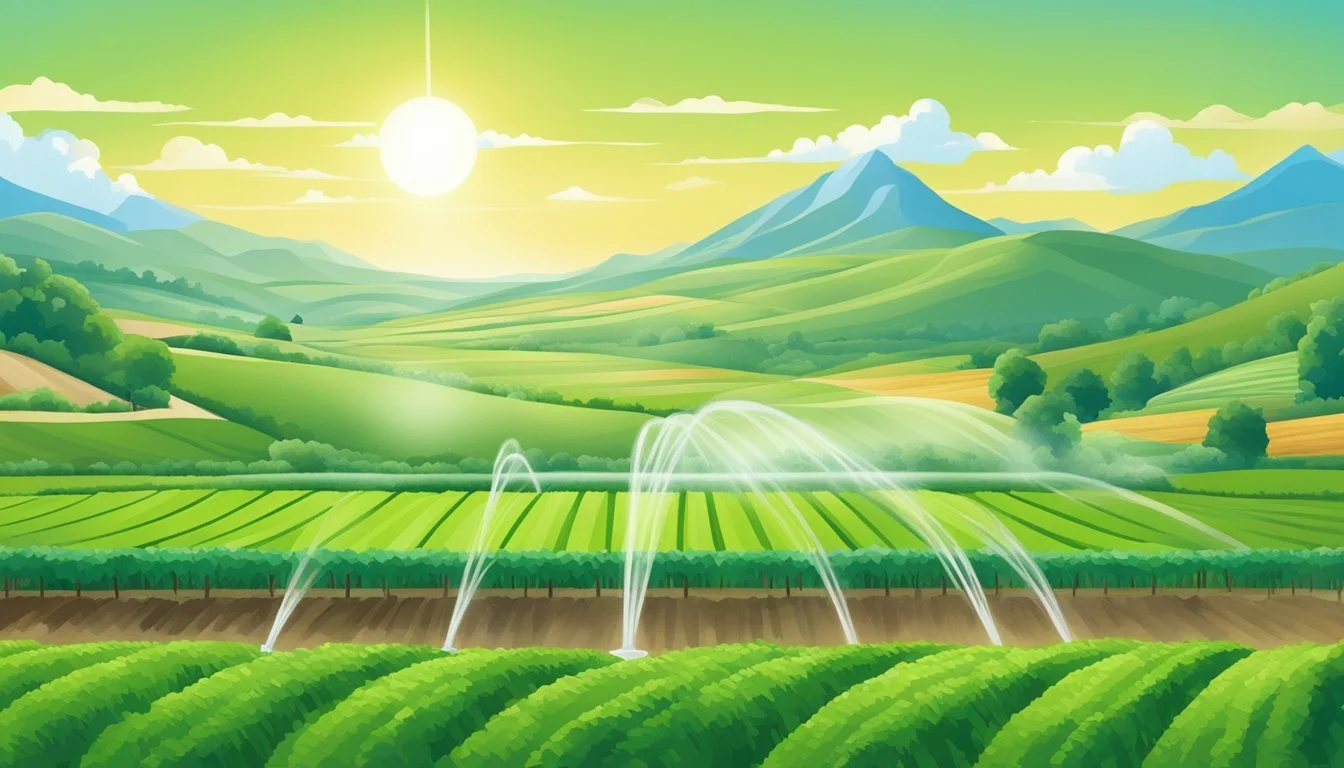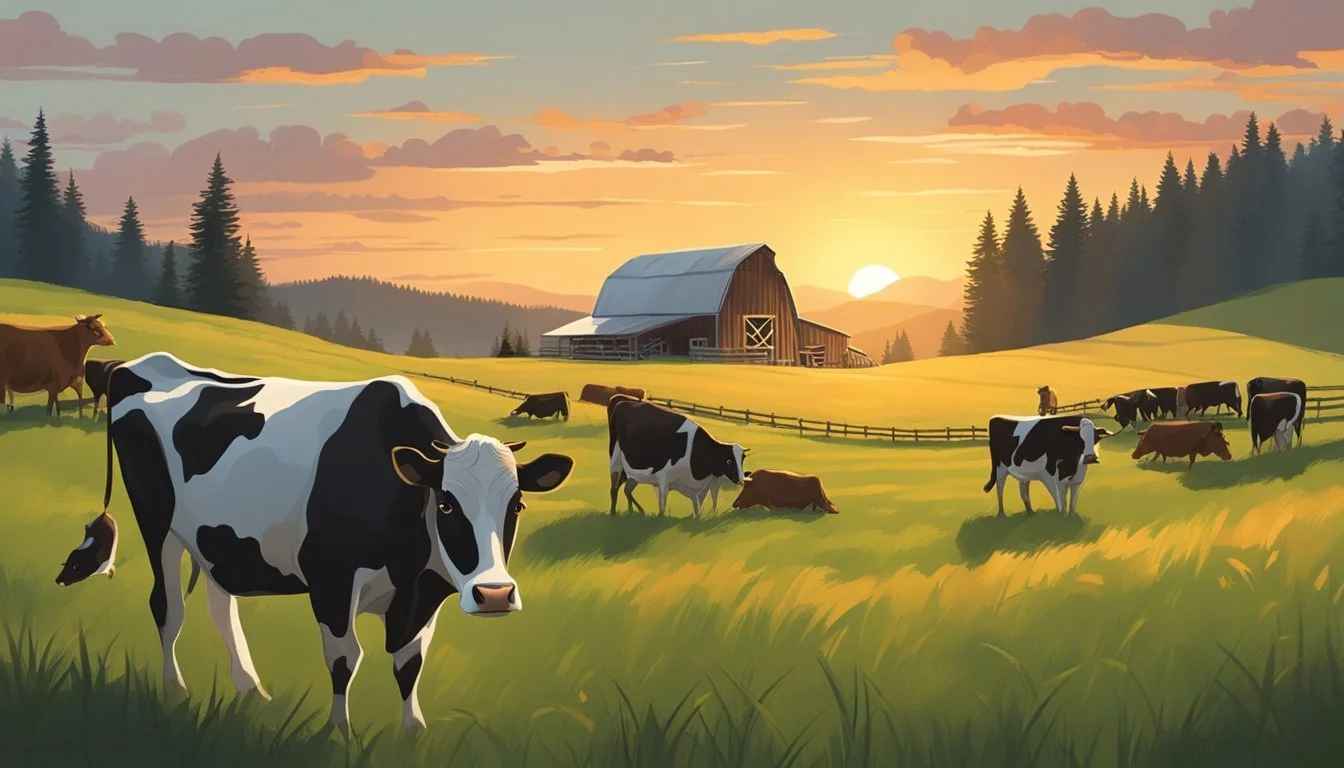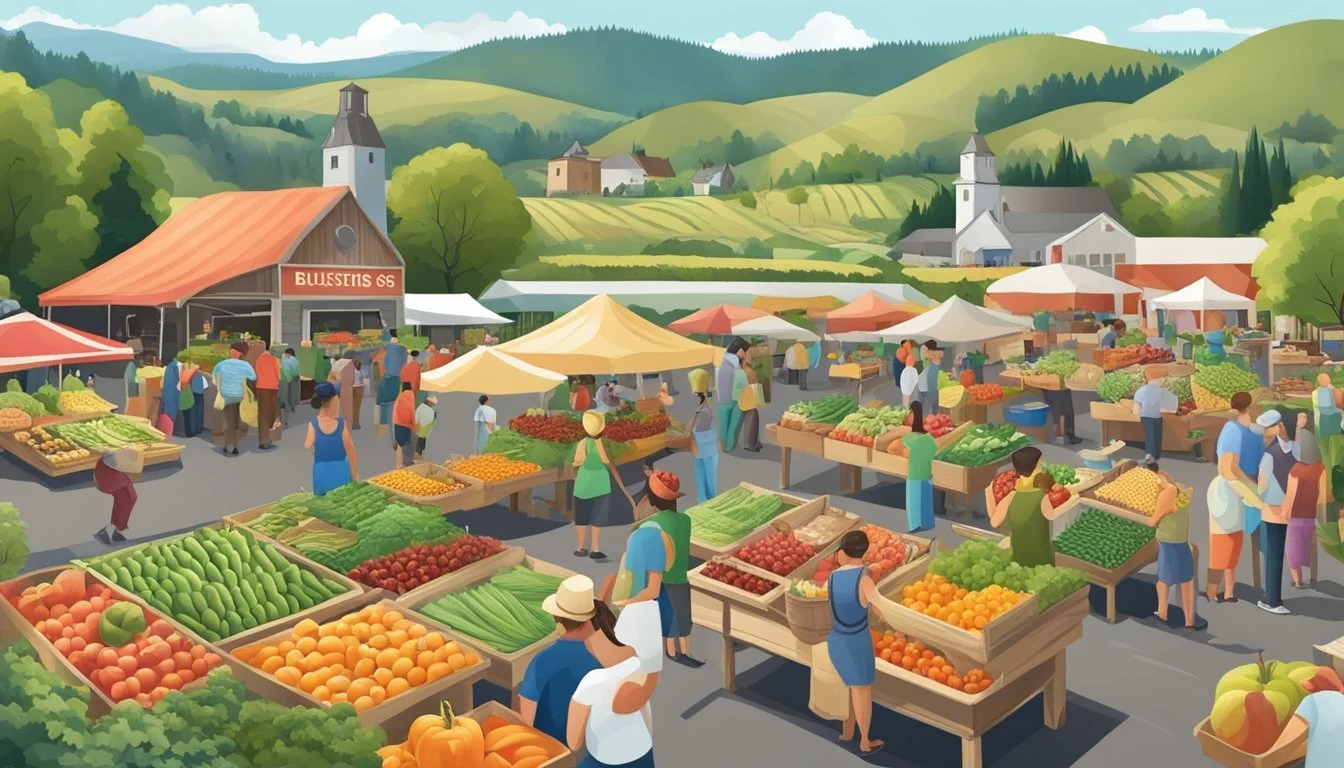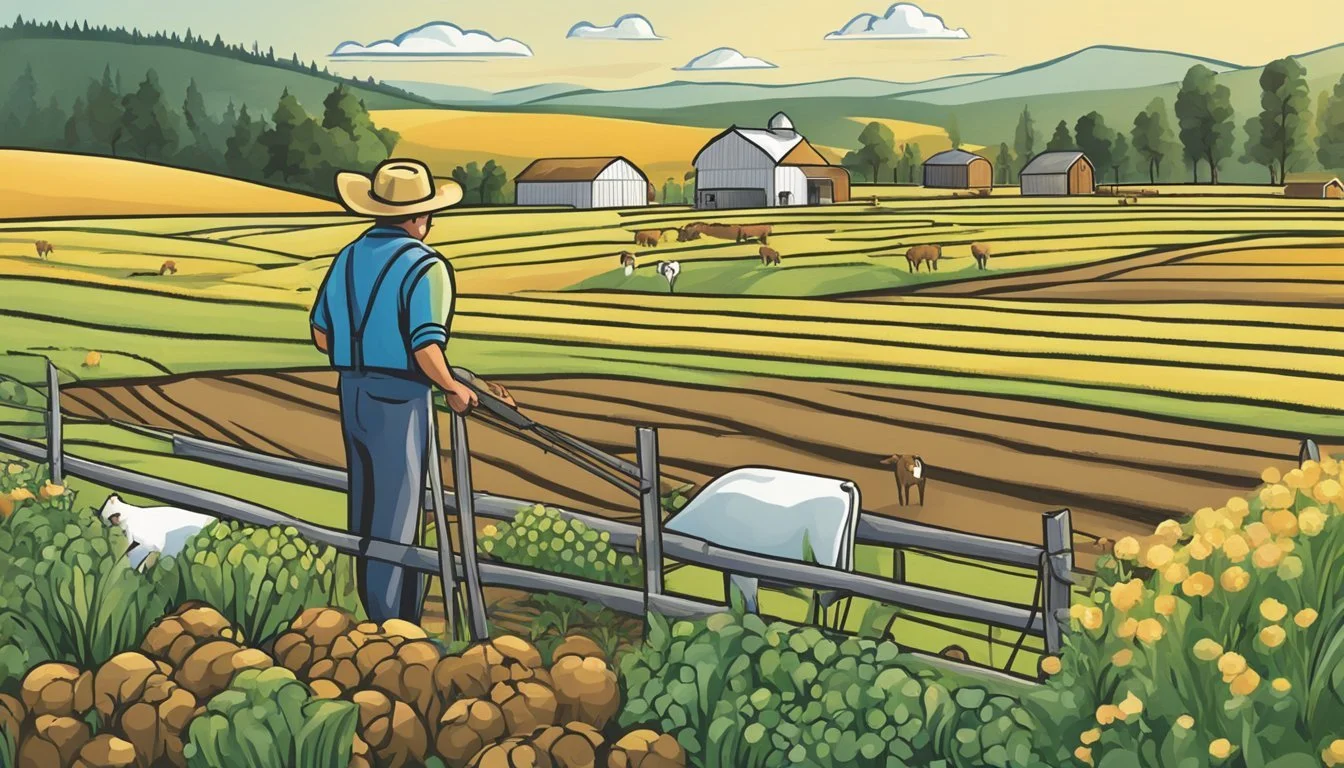Guide to Farming in Oregon
Essential Strategies for Success
This Article is Part of Our State by State Farming Guide
Oregon stands as a testament to agricultural variety and success, reflecting the state's unique ability to support a wide range of farming activities. With over 30,000 small farms, Oregon's agricultural landscape is as diverse as its ecosystem, ranging from the windswept coastlines through the fertile Willamette Valley, to the high desert and mountainous regions. The state's farmers are supported by a robust network of resources, including the Oregon Department of Agriculture and the United States Department of Agriculture, alongside valuable educational support from primary, secondary, and higher education institutions like Oregon State University.
The state's contribution to agriculture extends beyond the familiar – while it is a leading producer of wheat and potatoes, Oregon's agricultural output is impressively varied, boasting over 200 crop varieties including grass seed, alfalfa, barley, and specialty crops. The agriculture sector is not only significant for its diversity, but also for its impact on Oregon's economy, making up a substantial portion of the state's gross product and contributing significantly to its export revenues.
Institutions such as Oregon State University play a crucial role in this vibrant agricultural sector by providing education, training, and technical assistance, especially in areas like pest management and sustainable practices. This ensures that Oregon's farming community remains at the forefront of agricultural innovation, productivity, and sustainability, addressing crop-related issues and fostering continued growth and development within the local, national, and global markets.
Understanding Oregon Agriculture
Oregon's agriculture is a vital component of its economy, characterized by a diverse range of crops and commodities. The state thrives on a rich tradition of farming, supported by detailed agricultural statistics and an active Department of Agriculture.
Agricultural Statistics and Trends
Oregon consistently follows agricultural trends with a keen eye on sustainability and innovation. According to the latest data, agriculture contributes significantly to Oregon's gross product. Oregon agricultural statistics reveal that the sector generates upwards of $5 billion in agricultural production annually. The USDA NASS Statistical Bulletin provides an in-depth analysis of year-on-year trends, which are critical for farmers, policymakers, and industry stakeholders.
Key Crops and Commodities
Oregon's agricultural landscape is marked by its varied climate and topography, supporting a wide array of crops and livestock. The state is known for its production of:
Nursery and greenhouse products
Cattle and calves
Hay
Milk
Wheat
The Oregon state Board of Agriculture underscores the importance of these commodities, which not only cater to domestic needs but also contribute to the $2.57 billion in agricultural exports.
Role of the Oregon Department of Agriculture (ODA)
The ODA plays a crucial role in promoting and regulating the state's agricultural sector. Its vision encompasses ensuring a healthy natural resource base and a robust economy in Oregon's rural and urban communities. The department actively engages in various aspects, from food safety to environmental stewardship, and supports the industry's adaptation to changing needs and market demands.
Getting Started in Farming
Embarking on a farming career in Oregon requires a solid foundation and access to resources that support sustainable and profitable operations. For beginning farmers, understanding the essentials, leveraging educational programs such as those offered by Oregon State University (OSU), and creating a thorough business plan are critical steps.
Essentials for Beginning Farmers
Beginning farmers require a deep understanding of the agricultural landscape, including knowledge of local soil conditions, crop suitability, and climate factors. Access to capital, land, and equipment is also fundamental. They should explore support from organizations such as the Oregon Department of Agriculture (ODA) and the United States Department of Agriculture (USDA), which offer various programs including training, mentorship, and potential funding opportunities.
OSU Extension and Small Farms Program
The OSU Extension Service provides aspiring farmers with guidance through its Small Farms Program. This program offers comprehensive resources and educational opportunities to help new farmers understand agricultural principles and practices. Among the services provided are:
Workshops and courses on sustainable farming techniques
Networking events to connect with other farmers
Research-based guidance tailored to Oregon's diverse agricultural conditions
Creating a Business Plan
Every farmer must have a well-structured business plan to succeed. A good business plan should outline:
Vision and goals: A clear statement of the farm's objectives
Market analysis: Understanding of the target market and demand
Financial planning: Budgets, projected cash flows, and funding sources
Operations plan: Day-to-day activities, resource allocation, and management strategies
Such a plan becomes a roadmap for the farm's development and a tool to secure financing and check the progress of the farm's growth. Oregon State University's Whole Farm Management guide can be instrumental in assisting with this planning process.
Soil Preparation and Planting
Successful farming in Oregon demands careful soil preparation and adherence to the optimal planting dates. These fundamental steps ensure healthy growth and maximized yields for various crops.
Assessing Soil Quality and Needs
Farmers must first evaluate their soil to determine its texture, structure, nutrient levels, and pH balance. Clay soil, common in Oregon, may require amending to improve drainage and aeration. Soil tests should be taken to ascertain deficiencies and guide the amendment process, such as adding compost or other organic matter to enhance fertility. Regular soil tests and adjustments ensure the soil remains conducive to planting.
Optimal Planting Dates and Strategies
Planting dates: In Oregon, vegetable planting dates range from early spring to late summer, depending on the crop. Timing is critical as it aligns with creating the most favorable conditions for each vegetable's growth cycle.
Vegetable Type Suggested Planting Dates Frost-tolerant Early Spring (Feb-Apr) Warm-season After last frost (May-Jun) Fall-harvested Summer (Jul-Aug)
Strategies: Employ short rows or raised beds for easier management and to facilitate soil warming, especially beneficial for seed germination. For a continual harvest, use successive planting methods, spacing seedlings at intervals that accommodate their growth rate and size at maturity. Monitoring local vegetable variety trials can inform farmers of the most productive and disease-resistant species for their region.
Seasonal Farming Activities
In Oregon, farming activities are carefully timed with the changing seasons. Each season has specific tasks critical for successful crop production.
Spring Planting and Maintenance
With the arrival of spring, Oregon farmers begin the busy planting season. Fields are prepared and crops such as strawberries, which thrive from May to August, are planted. Maintenance includes soil fertilization, pest control strategies, and irrigation system checks to ensure optimal growing conditions for crops.
Key Spring Activities:
Preparing soil (tilling, fertilizing)
Planting spring crops (e.g. strawberries, rhubarb)
Initiating pest management systems
Irrigation set up and testing
Summer Care and Monitoring
Summer in Oregon calls for diligent care and monitoring of crops. The warmer weather accelerates growth, making it crucial to check for pests and diseases regularly. Irrigation is adjusted to cope with higher temperatures, ensuring plants receive enough water without waste.
Key Summer Activities:
Regular pest and disease inspection
Adjusting irrigation schedules
Crop maintenance (weeding, trellising)
Fall Harvest and Preparation for Winter
Fall signals harvest time in Oregon. Farmers are busiest as they gather the fruits of their labor, including apples, pears, and pumpkins. Once the harvest is complete, preparations for winter begin, such as pruning perennial plants and protecting them from the coming cold.
Key Fall Activities:
Harvesting fall crops (e.g. apples, pears)
Pruning and protecting plants for winter
Cleaning and storing farm equipment
Irrigation and Water Management
Effective irrigation and water management are pivotal for maintaining agricultural productivity in Oregon. They must account for the specific needs of varied crops and adhere to state water regulations.
Watering Techniques for Different Crops
In Oregon's diverse climate, different crops require tailored watering techniques to ensure optimal growth and water efficiency.
Watermelon: Due to their high water content, watermelons require careful irrigation. They thrive in temperatures between 65°F and 95°F. Drip or trickle irrigation delivers water directly to the root zone, reducing evaporation and conserving water during the heat.
Temperature considerations: Crop-specific irrigation also hinges on temperature management. During periods of high heat, irrigation schedules must be adjusted to provide adequate water without over-irrigation, which can lead to water wastage and nutrient leaching.
Navigating Water Rights and Regulations
Oregon's water rights and agricultural water management policies are designed to sustainably balance the needs of farmers with environmental conservation.
Water Rights: Farmers must navigate Oregon water law, which governs the allocation of water rights and prioritizes senior rights during shortages.
Regulatory Framework: The Oregon Agricultural Water Quality Management Act provides guidelines for agricultural water use. Farmers need to be familiar with the Oregon Department of Agriculture's guidelines to ensure compliance with state regulations and the protection of water resources.
Farm Infrastructure
Infrastructure is a critical component for the success of any farming operation in Oregon. Efficient farm infrastructure facilitates higher yields, quality of products, and overall farm sustainability.
Building and Managing Greenhouses
Greenhouse structures are vital in Oregon to extend the growing season and protect crops from variable weather conditions. Farmers must ensure that their greenhouses are strategically placed to optimize sunlight exposure while maintaining easy access to water and electricity supplies. Key factors in greenhouse management include:
Temperature control: Greenhouses should have a reliable system to regulate temperature, usually involving a combination of ventilation, heating, and shading.
Pest management: They should be equipped with screens and other preventive structures to minimize the risk of pest infestations.
Durability: The materials used must withstand Oregon's climate, which includes heavy rains and possible snow.
Investing in Quality Equipment
The right equipment is indispensable for effective farm management. Oregon farmers rely on various tools for daily operations, and investing in high-quality equipment often translates to long-term savings and efficiency.
Tractors: A foundational piece of farm machinery, tractors should be chosen based on farm size and the type of tasks they need to accomplish. Maintenance schedules for these machines are essential to ensure their longevity.
Technology Integration: Modern farming equipment often includes GPS and data analytics capabilities, assisting in precise fieldwork and decision-making processes.
Equipment Grants: Programs like the Resilient Food Systems Infrastructure Grant in Oregon offer financial support for equipment investments up to $100,000, aimed at enhancing farm productivity.
Animal Husbandry
In Oregon, the practices of animal husbandry involve dedicated care for livestock and the maintenance of poultry farming operations. These practices are essential for the state's agricultural success and encompass both traditional and contemporary methods to ensure animal health and product quality.
Caring for Livestock
Oregon farmers are responsible for the well-being of their livestock, which includes cattle and dairy cows, among others. They must provide adequate shelter, nutrition, and medical care. Here are the key components of proper livestock care:
Shelter: Livestock require protection from extreme weather conditions, be it severe heat or cold, along with sufficient space to move and rest.
Nutrition: A balanced diet is critical, and farmers must manage feeding schedules to maintain the animals' health and productivity.
Healthcare: Regular veterinary check-ups and vaccinations are fundamental to prevent diseases and promptly address any health issues.
Careful breeding practices and the humane handling of animals are also deeply incorporated into routine husbandry operations, albeit with recent scrutiny such as the proposed IP 13, which could impact such practices.
Poultry Farming Essentials
When it comes to poultry farming in Oregon, attention to detail is crucial. Farmers raise chickens primarily for their eggs and meat, and ensuring their health is paramount.
Housing: Chickens need a safe environment, protected from predators and extreme weather. The housing should provide enough space for natural behaviors.
Diet: A feed that meets all nutritional needs is essential for healthy poultry. It commonly consists of grains, protein sources, and vitamins.
Health Management: Disease prevention through biosecurity measures and regular health assessments keeps flocks productive and safe for consumption.
It should be noted that regulations, such as the United Egg Producers' Animal Husbandry Guidelines, might influence housing and care standards in poultry farming. Oregon provides diverse opportunities in farming through initiatives like the farmer training programs, indicating the state's commitment to sustainable and humane farming practices.
Market and Community Involvement
Oregon's agricultural community thrives on a network that facilitates the selling of produce and products while fostering close ties between farmers and Oregonians. Market involvement and community engagement are key avenues through which small and family farms in Oregon connect with their clientele and support each other.
Selling Produce and Products
Farmers in Oregon have a wealth of resources to support the sale of their produce. The Oregon Department of Agriculture (ODA) and the US Department of Agriculture (USDA) provide crucial assistance. They can access educational resources from primary, secondary, and higher education institutions to better understand market strategies and business management.
Participation in Farmers' Markets
Farmers' markets in Oregon serve as fundamental business incubators, with more than 90 markets accepting SNAP benefits and other food assistance programs. This inclusive approach ensures that fresh, healthy food reaches a wide spectrum of Oregonians and supports new entrepreneurs. Over half of the vendors at rural farmers' markets are newcomers, which illustrates how farmers' markets are pivotal in the cultivation of Oregon's agricultural community.
Community Supported Agriculture (CSA)
Community Supported Agriculture (CSA) programs are integral to Oregon's farming landscape, connecting consumers directly with local farms. Patrons of CSAs receive regular deliveries of fresh produce and products, thus investing in their community's farming endeavors. This model promotes sustainable agriculture and fosters a robust relationship between the state's residents and their local food systems.
Agricultural Education and Support Programs
In Oregon, individuals seeking careers in agriculture have access to a range of educational and support programs designed to equip them with the necessary knowledge and skills. These programs offer practical, hands-on learning experiences that can lead to successful careers in the farming sector.
OSU's Agricultural Courses
Oregon State University (OSU) offers comprehensive agricultural courses that cover various aspects of farming and agriculture management. Students can choose from undergraduate and graduate programs that focus on:
Crop and Soil Science
Soil health management
Animal Science
Livestock management
Veterinary science
Agricultural Business Management
Farm operations
Financial planning in agriculture
These courses combine classroom knowledge with real-world applications, preparing students for a diverse range of careers in the agricultural industry.
Rogue Farm Corps' Apprenticeship Programs
Rogue Farm Corps facilitates apprenticeship programs aimed at training the next generation of farmers:
The programs blend formal education with mentorship by experienced farmers.
Apprentices receive immersive, on-farm experiences complemented with classes on various farming techniques and business management.
This model provides a critical stepping stone for those interested in pursuing a future in sustainable agriculture and helps ensure the long-term viability of Oregon's farming community.
Challenges and Advocacy in Oregon Agriculture
Agriculture in Oregon faces a myriad of challenges from environmental to economic, with dedicated advocacy groups striving to provide support and legal aid to the farming community.
Identifying and Overcoming Farming Challenges
Climate Change and Environmental Stressors:
Wildfires and Heatwaves: These phenomena have intensified, signaling harsher farming conditions in the years ahead and the potential for decreased agricultural output.
Labor Shortage: A significant obstacle for farms, impacting their operational capabilities.
Soil Health and Climate Resilience: Advocated as a priority to sustain agriculture, soil health is crucial for carbon sequestration and combating climate change.
Economic and Health Equity Issues:
Rural Economic Development: Integral to supporting farming communities, emphasizing organic agriculture can yield health and economic benefits.
Market Challenges: Farmers must navigate fluctuating demand and pricing for agricultural commodities, which can impact their financial stability.
Advocacy Groups and Legal Support
Advocacy Organizations:
Friends of Family Farmers: Focused on promoting organic agriculture as a response to climate change, with benefits for rural communities and health equity.
Oregon Farm Bureau: The largest general agriculture advocacy organization in the state, representing diverse farm sizes and methods.
Oregon Climate and Agriculture Network (OrCAN): Works to improve farming practices related to soil health and climate resilience through support and education programs.
Legal Framework and Policy:
State Board of Agriculture Reports: Provide visibility into the facts, figures, and right improvements needed to support the sector’s sustainability.
Policy Advocacy: Informs legislative actions that foster a supportive environment for family farms and the greater agriculture industry in Oregon.
Agricultural commodities and their sustainable production remain central to these discussions, as they underpin the state's economic health and the well-being of Oregonians.
Sustainability and Innovation
Oregon's agricultural practices are continually evolving to prioritize sustainability and harness innovation. These efforts are not only preserving the environment but also enhancing efficiency in farming.
Practices for Sustainable Farming
Sustainable farming practices are crucial for the health of consumers, communities, and the environment. Oregon has embraced methods such as:
Crop Rotation: Diversifying crops to maintain soil health and reduce pests.
Integrated Pest Management (IPM): Utilizing environmentally sensitive approaches for pest control, minimizing chemical use.
Conservation Tillage: Reducing tillage frequency to maintain soil structure and minimize erosion.
Organic Farming: Encouraging many farms to adopt organic certification, emphasizing natural soil enhancement and avoiding synthetic chemicals.
Innovations in Agriculture Technology
Oregon's agricultural sector continuously integrates technological innovations to improve efficiency and production sustainability. Some of these advancements include:
Precision Agriculture: Utilizing drones and GPS technology for precise crop monitoring and resource management.
Water Efficiency Technologies: Implementing drip irrigation and moisture sensors to optimize water usage.
Renewable Energy Use: Harnessing solar and wind energy to power farm operations, reducing reliance on fossil fuels.
Biocontrol Agents: Deploying beneficial organisms as a natural alternative to chemical pesticides, promoting a balanced ecosystem.
Financial Resources and Grants
Navigating the financial landscape of agricultural funding in Oregon can be challenging. Farmers have a variety of grants and loans at their disposal, even though grants are not typically available for starting a farm.
Finding and Applying for Agricultural Grants
The process of obtaining grants in Oregon requires thorough preparation. It's crucial to have a business plan ready before exploring grant options. Grants are more readily available for established farms looking to expand, diversify, or implement sustainable practices rather than for initial startup costs.
State Programs: The Oregon Department of Agriculture (ODA) offers programs that may occasionally include grants for specific agricultural projects.
Federal Programs: The U.S. Department of Agriculture (USDA) provides a wider range of grants through programs like the Specialty Crop Block Grants and Farmers Market Promotion Program.
Directory of Resources for Farmers
Farmers in Oregon can rely on a comprehensive directory of agricultural resources for financial assistance and advice. Resources vary from the local to the federal level and are aimed at supporting small and new farms, as well as established operations.
State Resources:
Oregon Department of Agriculture (ODA)
Oregon’s educational institutions
Federal Resources:
USDA Farm Service Agency
USDA Natural Resources Conservation Service
USDA Rural Development
USDA National Institute of Food and Agriculture
Programs for Veterans:
Various USDA programs offer targeted aid and grants to veterans in agriculture.
Farmers are encouraged to research and contact these organizations to understand the specific grants available and the application process involved.
Oregon's Diverse Farming Regions
Oregon is renowned for its wide-ranging agricultural sectors, each distinct in the crops and commodities it produces due to the state's varied climate and geography.
Willamette Valley: Often referred to as Oregon's most versatile agricultural region, the Willamette Valley is home to a plethora of specialty crops. The fertile soils of the valley support a diverse range of produce:
Berries (such as blackberries and raspberries)
Hazelnuts
Hops
Nursery products
Southern Oregon: This region is characterized by its unique cultivation of tree fruits and potatoes, alongside a significant presence of livestock farming. Key products include:
Pears and other tree fruits
Potatoes
Oregon Coast: The coastal region primarily focuses on products from the sea and dairy farms. It's known for:
Fisheries
Dairy products
Columbia Basin: Agriculture here is shaped by the agrarian landscape and access to river irrigation, known for:
Wheat
Other grains
Each region's farming practices are influenced by local climates, from the wet conditions of the coast to the drier inland areas, which affects the type of irrigation used. Soil types also vary considerably, from rich alluvial to volcanic, providing a basis for Oregon's agricultural abundance.
Subsections
Oregon Coast Known for its unique climate and topography, the Oregon Coast offers favorable conditions for specific crops such as cranberries and nursery stock. It's a region where the maritime influence shapes the agricultural practices.
Willamette Valley Subsections Willamette Valley, encompassing counties like Benton, Clackamas, Linn, Marion, Polk, Washington, and Yamhill, is renowned for its fertile soil. This region specializes in a variety of crops including:
Benton County: Emphasizes on grass seed production.
Marion County: Prolific in berries, cherries, and nursery plants.
Yamhill County: Known for vineyards and wine production.
Eastern Oregon Counties such as Morrow reflect a different aspect of Oregon agriculture, with a focus on wheat and other cereal crops owing to its drier climate.
Urban Influence Urban proximity, especially in counties like Multnomah, has led to a rise in small-scale, diverse farming operations catering to the local food markets.
Zoning and Regulations Agricultural practices in Oregon are influenced by zoning laws, such as the Exclusive Farm Use zones, ensuring protection of farmland and promotion of profitable farming practices.
Future Transitions With a significant proportion of farmland expected to change hands in the coming years, this region faces a transitional phase, especially considering the aging population of farmers.
Each region within Oregon combines unique geographical, climatic, and social factors, contributing to the state's agricultural mosaic, and requiring adherence to specific zoning laws and practices to ensure sustainable and profitable farming.












